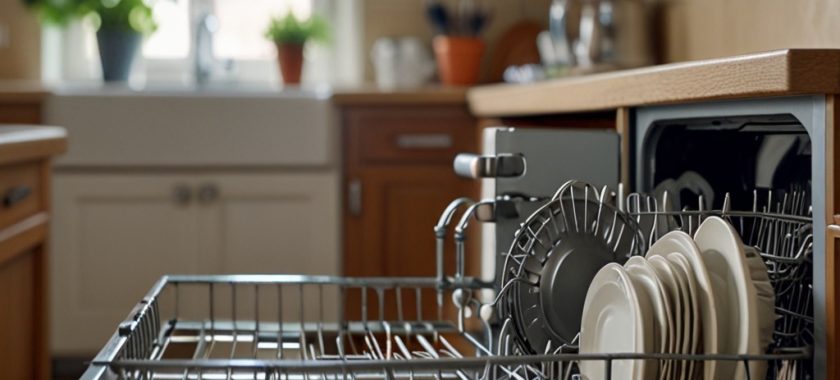A dishwasher is one of the most convenient appliances in any kitchen, designed to save time and effort. But what happens when you open the dishwasher after a full cycle, only to find that your dishes are still dirty? Frustration and disappointment are common reactions, and this issue could point to a variety of problems, ranging from user error to mechanical malfunction. In this article, we’ll explore the common reasons why dishes might remain dirty after a dishwasher cycle and how you can address these problems. If these solutions don’t work, it may be time to seek professional help from Chula Vista Appliance Repair Company.
⠀
- Improper Loading of Dishes
One of the most frequent culprits behind dirty dishes is improper loading. If dishes are placed too close together or loaded in such a way that water and detergent can’t reach all surfaces, some items may come out dirty. Make sure dishes are loaded with enough space between them, and avoid overcrowding the machine. Heavily soiled items should be positioned near the center of the dishwasher where the water jets are most powerful.
⠀
Solution: Always load dishes properly, following the manufacturer’s guidelines. Separate utensils, plates, and pans to ensure water can circulate freely.
⠀
- Using the Wrong Detergent
Not all detergents are created equal, and using the wrong one can leave your dishes less than spotless. Low-quality or expired detergent might not dissolve properly, leaving residue on your dishes. Additionally, certain types of detergent are designed for specific water hardness levels. If the detergent doesn’t match the water quality in your area, it can impact cleaning efficiency.
⠀
Solution: Ensure you’re using a high-quality detergent that is appropriate for your dishwasher model and water hardness. Check for any detergent clumps and make sure to measure the amount according to your dishwasher’s instructions.
⠀
- Clogged Spray Arms
The spray arms in your dishwasher are essential for delivering water and detergent to every corner of the machine. If these arms become clogged with food debris, minerals, or other particles, they may not rotate properly, or water might not be sprayed effectively. This can leave dishes dirty and covered in residue.
⠀
Solution: Regularly check and clean the spray arms to ensure they are free of obstructions. You can easily remove them, clean out any debris, and reinstall them to restore functionality.
- Low Water Temperature
For your dishwasher to effectively clean dishes, the water needs to be hot enough—usually at least 120°F (49°C). If the water entering your dishwasher isn’t hot enough, detergent may not dissolve correctly, and food particles may not be properly removed.
⠀
Solution: Run your kitchen faucet on hot for a few moments before starting your dishwasher to ensure the water entering the machine is hot. If this doesn’t work, you may need to adjust the settings on your water heater.
⠀
- Hard Water Build-Up
Hard water can leave behind mineral deposits that cause a film or cloudiness on your dishes. Over time, these deposits can build up inside your dishwasher and reduce its effectiveness. Hard water can also prevent detergent from dissolving properly, further reducing cleaning power.
⠀
Solution: Install a water softener or use a dishwasher cleaner specifically designed for hard water. Regular cleaning of your dishwasher with a vinegar rinse can help reduce mineral build-up as well.
⠀
- Malfunctioning Dishwasher Parts
If you’ve tried all of the above solutions and your dishes are still dirty after a cycle, it may be time to inspect your dishwasher for faulty parts. A broken pump, malfunctioning heating element, or clogged filter could be preventing your dishwasher from operating correctly. In these cases, the best solution is to have the appliance repaired by a professional.
⠀
Solution: Regular maintenance can prevent dishwasher malfunctions, but if a part is broken, it may need to be replaced. Consider calling a professional repair service for a thorough inspection.
⠀
- Old or Worn-Out Dishwasher
If your dishwasher is over 10 years old, it may be nearing the end of its life cycle. Over time, the efficiency of dishwashers can decline, making it more challenging for them to perform at their best. If you’ve tried every troubleshooting option and nothing seems to help, it might be time to replace the machine altogether.
⠀
Solution: Look for signs that it’s time to invest in a new dishwasher, such as frequent repairs, a noisy machine, or consistently poor cleaning results despite proper use. If you’re unsure, consult with a professional technician.
⠀
Get Professional Help
Dirty dishes after a dishwasher cycle can be a major inconvenience, but it doesn’t always mean that your machine is broken. By following proper loading techniques, using the correct detergent, and regularly cleaning your dishwasher, you can often resolve the issue on your own. However, if your dishwasher still isn’t cleaning properly, it might be time to bring in the experts.
⠀
At Chula Vista Appliance Repair Company, we specialize in diagnosing and fixing dishwasher problems to ensure your machine is working as efficiently as possible. Our experienced technicians can quickly identify any issues, whether it’s a mechanical failure or a simple part replacement, and provide you with a solution that fits your needs. Don’t let dirty dishes disrupt your day—contact us today to schedule a service appointment and get your dishwasher back in top shape!
Contact us
(619) 880-5508


